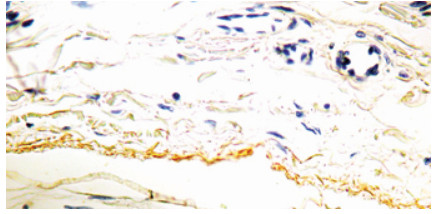ELN Mouse Monoclonal Antibody [Clone ID: BA-4]
CAT#: DM230
ELN mouse monoclonal antibody, clone BA-4, Ascites
Need it in bulk or conjugated?
Get a free quote
CNY 6,952.00
货期*
4周
规格
| Cited in 1 publication. |
Specifications
| Product Data | |
| Clone Name | BA-4 |
| Applications | IHC, WB |
| Recommend Dilution | Immunohistochemistry on Frozen and Paraffin Embedded Sections: Use 1/50-1/100 dilution in an ABC method for 30 minutes at RT. Proteolytic treatment prior to immunostaining is required for formalin fixed tissue sections. Recommended Positive Control: Heart, Kidney. |
| Reactivity | Canine, Feline, Guinea Pig, Goat, Human, Porcine, Sheep |
| Host | Mouse |
| Clonality | Monoclonal |
| Immunogen | Bovine alpha-Elastin. |
| Specificity | This antibody recognizes insoluble Elastin, alpha-Elastin, soluble non-cross linked precursor of Elastin (Tropoelastin). Cellular Localization: Connective tissue. |
| Formulation | State: Ascites State: Liquid Diluted Ascites Preservative: < 0.1% Sodium Azide |
| Conjugation | Unconjugated |
| Storage Condition | Store undiluted at 2-8°C for one month or (in aliquots) at -20°C for longer. Avoid repeated freezing and thawing. |
| Database Link | |
| Background | Elastin is an important polymeric protein of connective tissue that imparts elasticity to vertebrate elastic tissues. Elastin is a protein in connective tissue that is elastic and allows many tissues in the body to resume their shape after stretching or contracting. Elastin helps skin to return to its original position when it is poked or pinched. Elastin is also an important load-bearing tissue in the bodies of mammals and used in places where mechanical energy is required to be stored. Elastin is particularly abundant in large elastic blood vessels such as the aorta. It is also very important in the lungs, elastic ligaments, the skin, the bladder, and elastic cartilage. Elastin is composed largely of glycine, proline, and other hydrophobic residues and contains multiple lysine-derived crosslinks, such as desmosines, which link the individual polypeptide chains into a rubberlike network. The hydrophobic regions of the chains, between the crosslinks, are highly mobile. The hydrophobic and crosslinking domains are coded by separate, small (27 to 114 bp) exons that are separated by large introns. The initial translation product is a 72,000-dalton polypeptide, designated tropoelastin. Elastin is made by linking many soluble tropoelastin protein molecules, in a reaction catalyzed by lysyl oxidase, to make a massive insoluble, durable cross-linked array. |
| Synonyms | ELN, Tropoelastin |
| Reference Data | |
Citations (1)
| The use of this Antibodies has been cited in the following citations: |
|---|
|
Impact of cryopreservation on extracellular matrix structures of heart valve leaflets
,Schenke-Layland K, Madershahian N, Riemann I, Starcher B, Halbhuber KJ, Kvnig K, Stock UA,
Ann. Thorac. Surg.
,PubMed ID 16488695
[ELN]
|
Documents
| Product Manuals |
| FAQs |
| SDS |
Resources
| 抗体相关资料 |
Customer
Reviews
Loading...


 United States
United States
 Germany
Germany
 Japan
Japan
 United Kingdom
United Kingdom
 China
China

